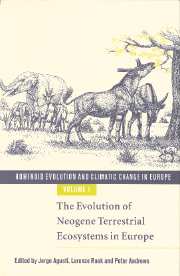Book contents
- Frontmatter
- Contents
- List of contributors
- Acknowledgements: The European Science Foundation
- 1 Introduction
- PART I Palaeogeography of the circum-Mediterranean region
- PART II Miocene mammalian successions
- PART III Palaeoenvironments: non-mammalian evidence
- 14 Marine invertebrate (chiefly foraminiferal) evidence for the palaeogeography of the Oligocene–Miocene of western Eurasia, and consequences for terrestrial vertebrate migration
- 15 Palaeoclimatic implications of the energy hypothesis from Neogene corals of the Mediterranean region
- 16 Contribution to the knowledge of Neogene climatic changes in western and central Europe by means of non-marine molluscs
- 17 Sedimentary facies analysis in palaeoclimatic reconstructions. Examples from the Upper Miocene–Pliocene successions of south-central Tuscany (Italy)
- 18 Neogene vegetation changes in West European and West circum-Mediterranean areas
- PART IV Palaeoenvironments: mammalian evidence
- Index
18 - Neogene vegetation changes in West European and West circum-Mediterranean areas
from PART III - Palaeoenvironments: non-mammalian evidence
Published online by Cambridge University Press: 15 December 2009
- Frontmatter
- Contents
- List of contributors
- Acknowledgements: The European Science Foundation
- 1 Introduction
- PART I Palaeogeography of the circum-Mediterranean region
- PART II Miocene mammalian successions
- PART III Palaeoenvironments: non-mammalian evidence
- 14 Marine invertebrate (chiefly foraminiferal) evidence for the palaeogeography of the Oligocene–Miocene of western Eurasia, and consequences for terrestrial vertebrate migration
- 15 Palaeoclimatic implications of the energy hypothesis from Neogene corals of the Mediterranean region
- 16 Contribution to the knowledge of Neogene climatic changes in western and central Europe by means of non-marine molluscs
- 17 Sedimentary facies analysis in palaeoclimatic reconstructions. Examples from the Upper Miocene–Pliocene successions of south-central Tuscany (Italy)
- 18 Neogene vegetation changes in West European and West circum-Mediterranean areas
- PART IV Palaeoenvironments: mammalian evidence
- Index
Summary
Introduction
The value of pollen records for vegetation and climate reconstructions is now well-established. Above all, the West Mediterranean region is highly documented, especially for what concerns the Lower Pliocene (Suc et al., 1995a) and offers a favourite Weld for climatic quantifications (Fauquette et al., 1998a, 1998b and in press). The next step is to construct vegetation maps in order to (1) emphasize new problems for a better understanding of past and modern ecosystems, (2) to estimate vegetation changes on a large geographic scale, and (3) to provide data (on the continental carbon mass for example) to climate modellers (Chandler et al., 1994; Sloan et al., 1996). The first aim of this paper is to lay the foundations of such a project for the Mediterranean and Western European regions. Then, a review of vegetation changes throughout the whole Neogene is presented concerning a region rich in data (Southwestern Europe). Most of the pollen localities used in this paper are chronologically well-calibrated according to foraminifers and/or nannoplankton and, for some of them, palaeomagnetism and rodents (for more details, see Bessedik, 1984; Suc, 1989; Suc et al., 1995a).
Vegetation maps
Validation of pollen records
Modern pollen spectra (lacustrine, lagoonal or marine surface samples) are compared to present-day vegetation on a map which also takes into account cultivated surfaces (Fig. 18.1). We now make some comments on the value of pollen data. Warm-temperate deciduous trees are mostly predominant in the Northwestern Mediterranean area and northward. Pines and non-identified Pinaceae (poorly preserved pollen grains) are often over-represented because of their prolific production and the advantage they have in air and water transport.
- Type
- Chapter
- Information
- Hominoid Evolution and Climatic Change in Europe , pp. 378 - 388Publisher: Cambridge University PressPrint publication year: 1999
- 14
- Cited by



